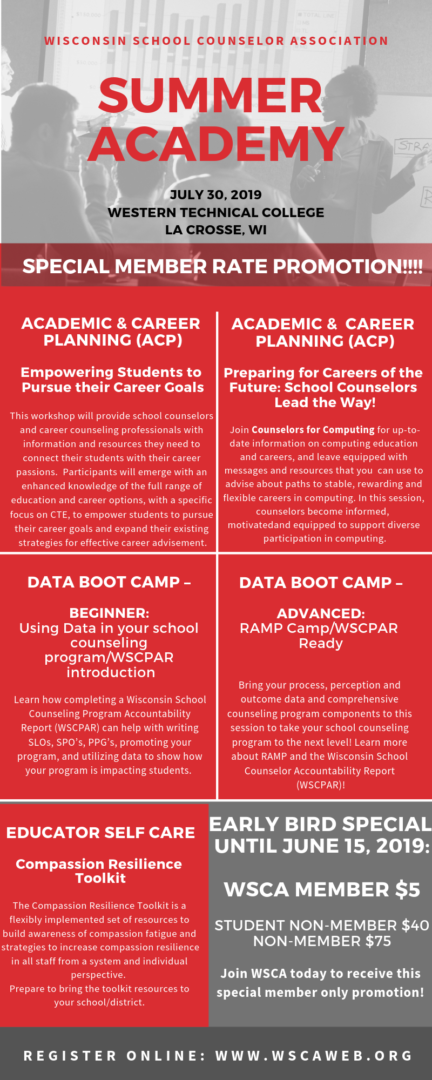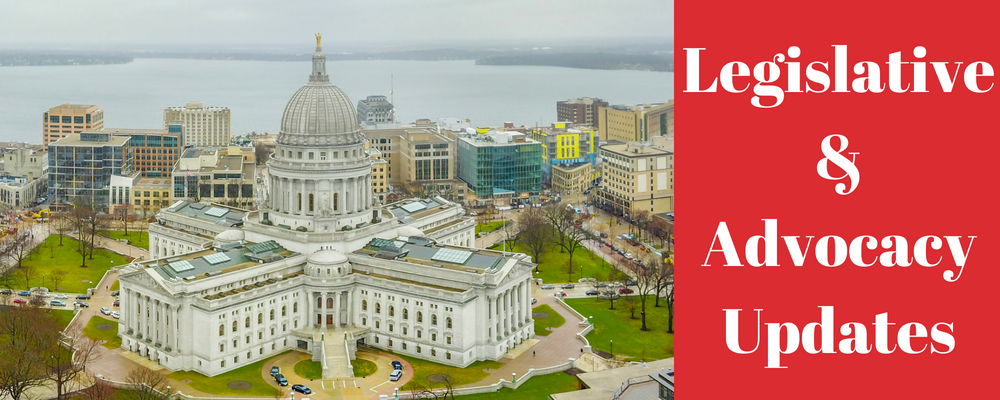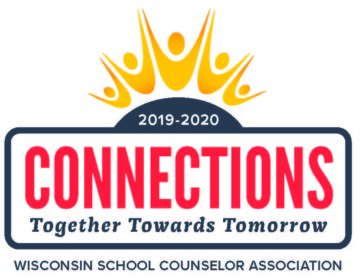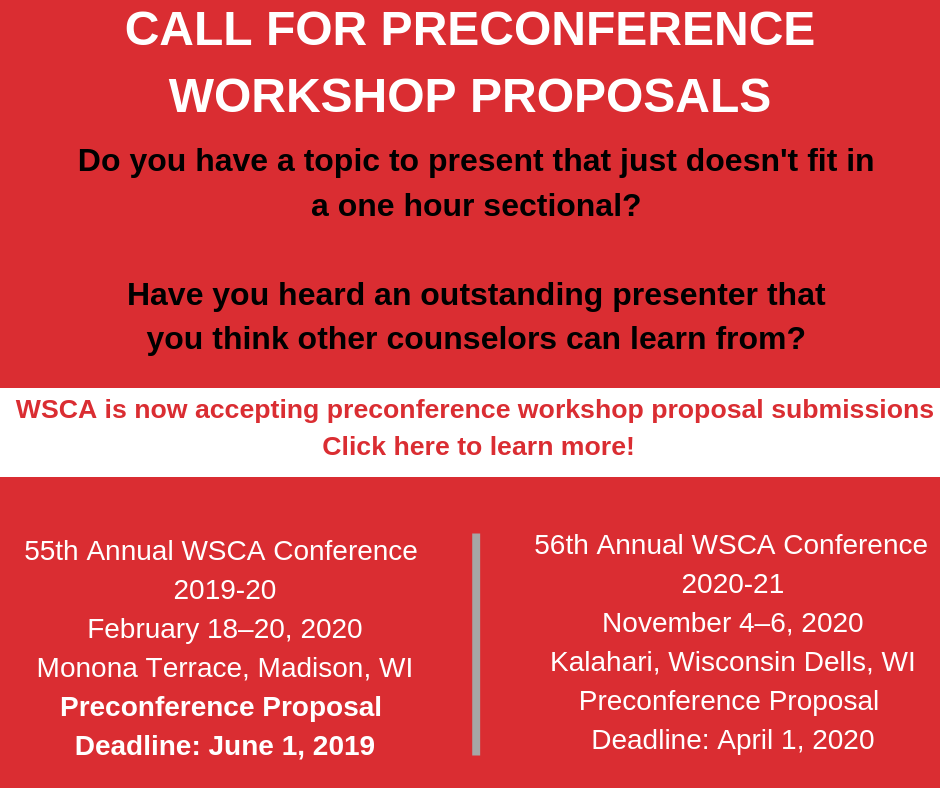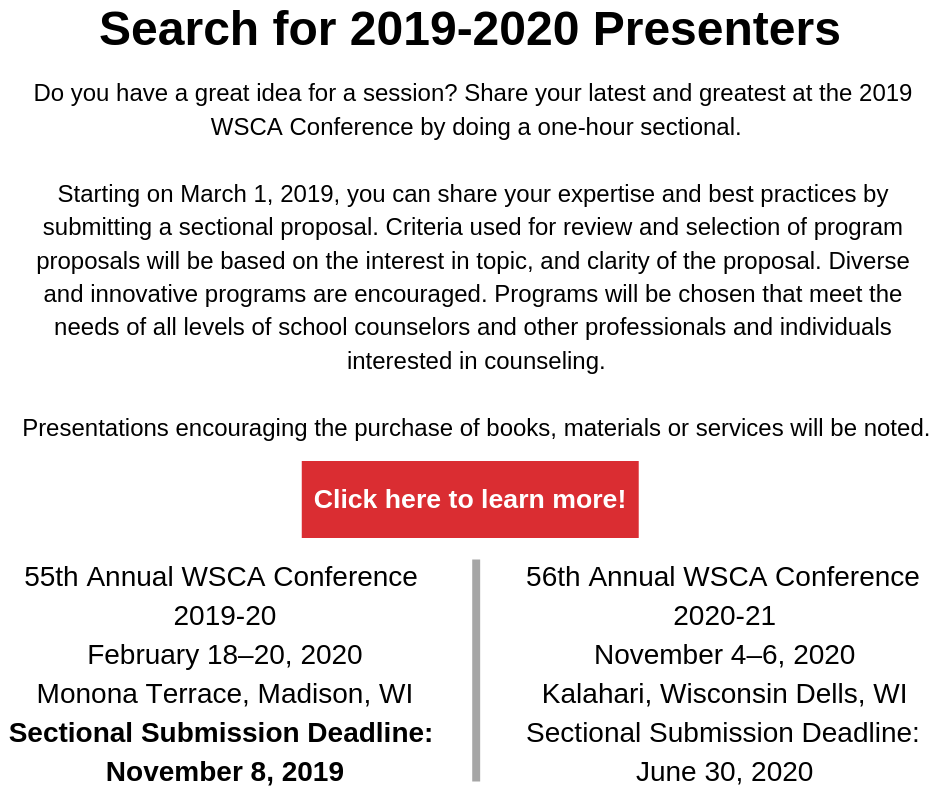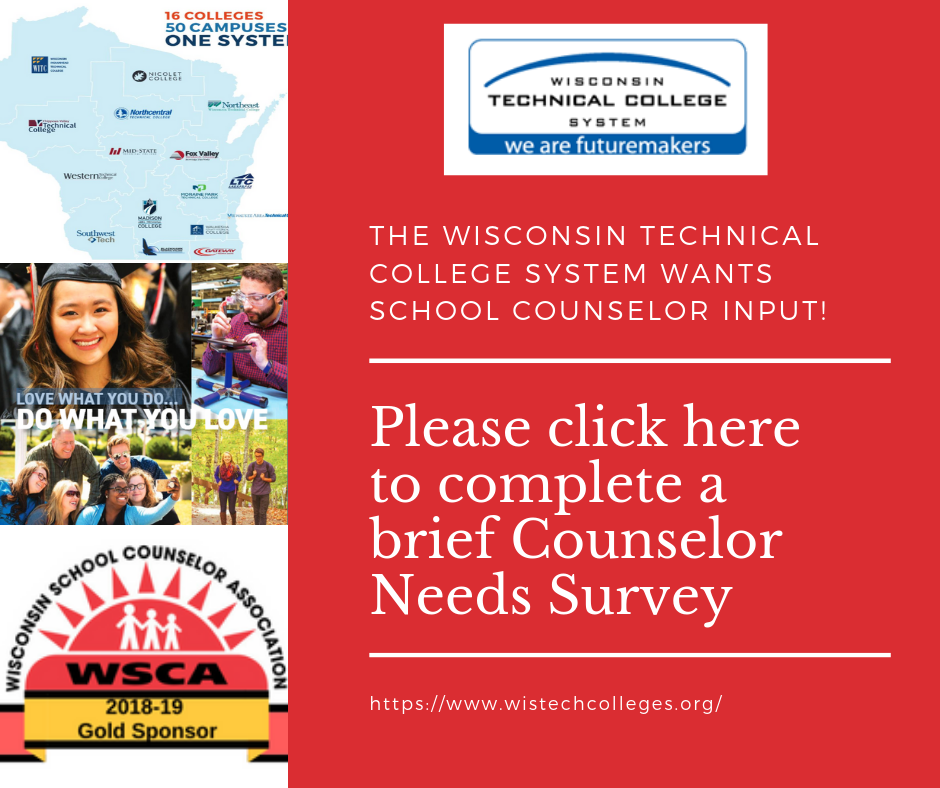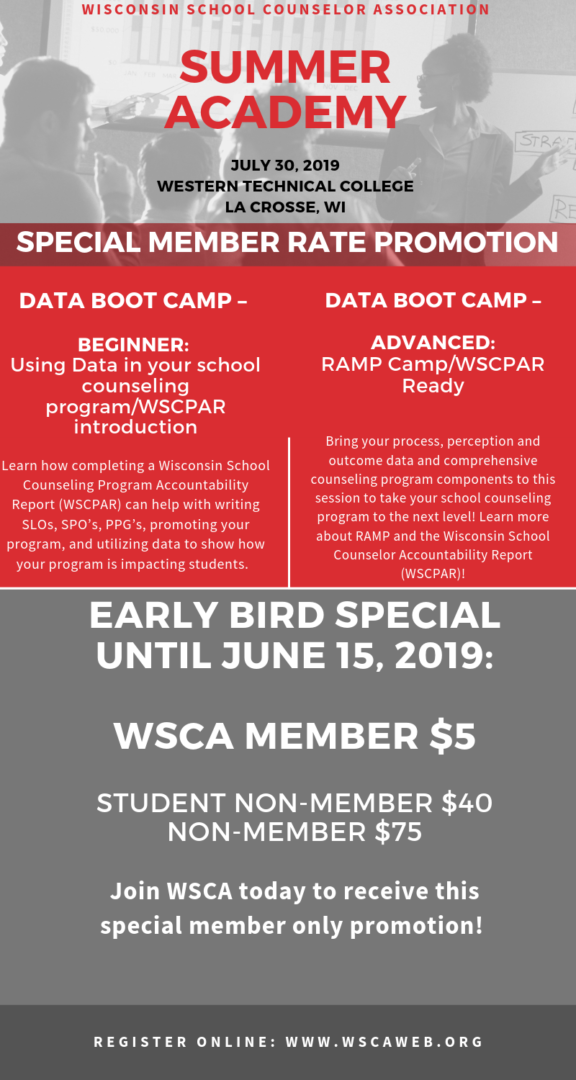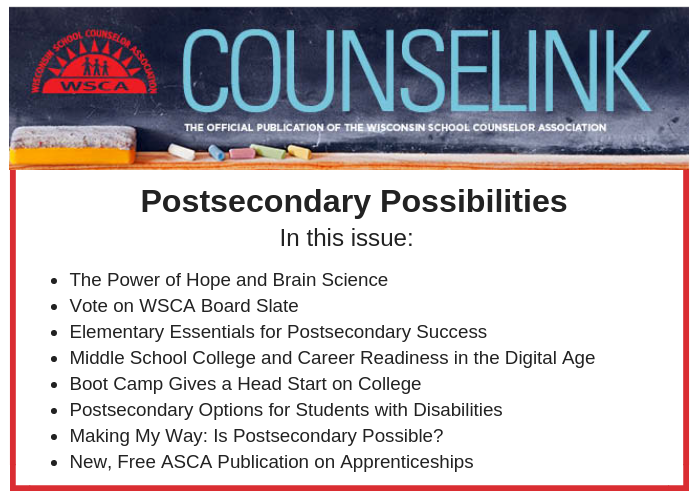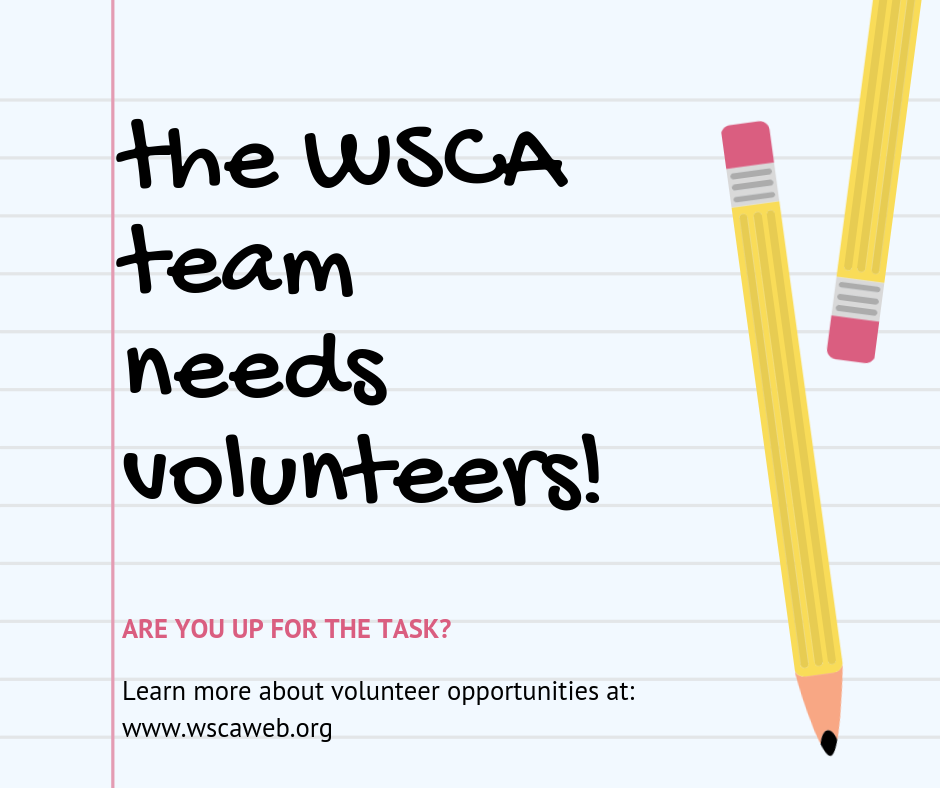May 2019

In This Issue:
A Message from DPI: Title IX the Cliff Notes
A Message from the WSCA Board: Saying Yes to Yourself
Feature Article: Classroom Management – The School Counselor Top 10 List
Special Summer Academy Promotion!
Legislative Update – Action Needed: BUDGET Update
2019-2020 Conference: Call for Presenters
WI Technical College Survey
ASCA Helpful Tips – Data Boot Camp at Summer Academy
FAFSA Student Level Data – WISEdash for Districts
Counselink
Summer Academy and Fall Summit
WSCA Volunteers NeededA Message from the the DPI
Title IX the Cliff Notes®
Gregg Curtis, PhD; School Counseling Consultant
Among the plethora of phone calls and emails I get from parents, students, and schools, some of the most distressing involve the topic of gender-based school violence. It seems that these occur on a near weekly basis, and some of them involve situations that attract an abundance of media attention; most frequently focused on what schools are or are not doing to protect students. I know that you all are often the frontlines folks who work directly with the victims, families, and/or alleged perpetrators to keep everyone safe, and you are often looked to as the “experts” in non-academic challenges. Therefore, I thought I would take this month to provide some clarification and resources about schools’ responsibilities should you find yourself in this type of situation.
First, the basics: it is important to recognize that gender-based school violence is covered under Title IX of the Education Amendments of 1972; which applies to any institution that receives federal financial assistance from the US Dept. of Education. This includes K-12 education (local education agencies and state agencies), higher education, charter schools, and libraries. The primary enforcement body for Title IX is the US DOE’s Office of Civil Rights; and the specific office that handles Wisconsin complaints is located in Chicago. Federal resources addressing Title IX can be found here. I can’t tell you how many times I’ve directed students, parents, and/or schools to these resources; so I encourage you to bookmark them.
In addition, students may be protected under Wisconsin’s pupil non-discrimination program . The pupil nondiscrimination program provides technical assistance to local school districts, parents and school district residents on matters relating to nondiscrimination and equality of educational opportunity under state law and related federal laws, and the pupil discrimination complaint and appeal process under state law and rules. (Section 118.13, Wis. Stats. and PI 9, Wis. Admin. Code). The pupil nondiscrimination program also assists the State Superintendent resolve appeals of local school district decisions on pupil discrimination complaints.
As part of this protection, districts are required to have written policies that prohibit discrimination against pupils for any of the reasons listed above. Each district must also have some way for pupils, their parents or guardians, or residents of the school district to file complaints of discrimination. The school board must approve a procedure for filing complaints of discrimination. The complaint procedure must be in writing. And each school district must name an employee of the school district who will be responsible for receiving complaints of discrimination against pupils. Schools must include information about these policies and procedures in any handbooks they have for teachers, students and parents.
Resources that may be handy for you to bookmark for your students and/or families include a pupil non-discrimination brochure and the complaint guide.
Next, we must unpack the term “gender-based school violence.” Most generally, gender-based violence and harassment are behaviors that are committed because of a person’s gender or sex (ACLU). They can be verbal, physical, or media-based in nature; and they occur in both male-to-female and female-to-male dynamics. While it is a fact that females are most often the targets of gender-based violence or harassment, we must not discount reports coming from male targets and recognize that societal norms and/or stigma may cause female-to-male incidents to go unreported.
Examples that may constitute gender-based violence or harassment include situations where someone:
- follows you around, always wants to know where you are and who you are with, or stalks you
- pressures you to perform sexual acts
- touches you sexually against your will
- forces you to have sex
- interferes with your birth control
- verbally abuses you using anti-gay or sex-based insults
- sends you repeated and unwanted texts, IMs, online messages, and/or phone calls that harass you
- hits, punches, kicks, slaps, or chokes you
- verbally or physically threatens you
So, when do schools have to do something and what do they need to do? Essentially, schools are required to act if the violent or harassment behaviors are so severe or frequent that they deprive the target of equal access to educational activities (including extra and co-curricular) AND the school has authority over the individual or group who are doing the behaviors and the environment in which it is happening. (ACLU Source Material) These environments would include the school day (before/after school programs and detention), school-provided transportation to/from school, school-sponsored activities like sports, clubs, dances, etc.
What must a school do? Primarily the school is obligated to provide a safe environment for all students. Students who report gender-based violence or harassment must have access to all educational activities free from the violent or harassing behavior and/or individual(s) who are alleged to have done the violence or harassment AND free from any retaliation from other students and adults. Most schools develop a “Title IX” or “Safety” plan for the student who reports gender-based violence that ensures their safety, and this plan takes into account the enforcement of any legally ordered restrictions of access and protection. This fact sheet outlines the do’s and don’ts for schools.
While my hope of hopes is that you won’t ever need any of this information or material, the reality is that most of you will at some point in your career. In that case, my hope is that you’ll do an awesome job counseling and protecting affected students and you’ll find this month’s message and resources helpful.
A Message from the WSCA Board of Directors
Saying Yes to Yourself
Tricia Norby, WSCA Board Member
As school counselors, we are helpers. We are givers. We are caretakers. We also have to-do-lists a mile long that stress us out because we know we will never get to everything on our lists—both in our personal and professional life. And that’s okay! It’s what makes us uniquely suited for our careers but it also can be our biggest weakness.
Five or six years ago I ran into one of my practicum supervisors at the WSCA conference and we went through the typical, “Hi! How are you…” and I replied with my usual complaint of, “Crazy busy,” because that is what my life felt like. Crazy to the point of unmanageable because of how many commitments I had taken on. I’ll call her Jen (because that’s her name-no privacy protection here) said, “Wow. That’s a lot.” For the first time, instead of just feeling how busy my life was, I started to think about how busy it was.
The next thing that Jen said helped shape how I manage my life to this day. She said, “Just remember, whenever you say yes to something, you are also saying no to something else.” We both then rushed off to get a seat at our next sectional and I didn’t see Jen again until the next year’s conference.
For the rest of the week I thought about what Jen said. Then I really thought about it and realized that when I say yes to evening committee meetings, I am saying no to dinner with my family. When I am saying yes to writing an article, I am saying no to focusing on my daughter’s soccer games. When I say yes to answering work emails when I’m at home, I am saying no to spending time with my husband.
That two-minute conversation with Jen led to my first, Year to Say No (that’s what I still call it). I decided that for the rest of the year I was going to say no to extra commitments AND remove myself from other commitments that I wasn’t truly passionate about and didn’t involve my family (I’m still not passionate about soccer but I am about my kids). I removed myself from 56 email lists—crazy, right (both that there were that many and that I counted)! I respectfully removed myself from a community coalition that I helped start six years previous but was no longer passionate about. When asked to take on something new, I simply say, “I’m sorry, it’s my year to say no.” I have found that every other year is enough to say yes to new interests and opportunities followed by a year of saying no so I can re-evaluate what’s important and valuable, both professionally and personally. I encourage you all to start saying no more often so that you can say yes to yourself and the things that you truly value!
Classroom Management – The School Counselor Top 10 List
By Vicki Feltz
Vicki Feltz is an Elementary School counselor, with professional experience of almost 20 years as a School Counselor at both the high school and elementary levels.
Create Your Expectations for Your Students Right Away – What do we look like, sound like, and feel like when we are listening, paying attention, sharing our ideas, turning/talking with a partner, transitioning, etc. during our guidance lessons? Consistency is key and tie your expectations to your school-wide or individual classroom PBIS expectations. Teach, model, practice, and reinforce!
Build Rapport – Let students know that you care about them and connect with them outside of the classroom. Find something that you can talk about and relate with the kids about. Knowing music, sports, movies, social media, phrases, etc. that the kids like (pop culture) can go a long way to build a positive connection with kids.
Use Positive Reinforcement vs Correction – 4:1 Ratio positives to corrections, BE SPECIFIC and descriptive about what they are doing right! “I noticed that you raised your hand before you shared your idea….that was so respectful toward me and the class!” “I like the way that students are coming to the carpet and are getting settled quietly in their spot…..amazing leadership!”
Be Prepared, Organized,……..but FLEXIBLE! – Be overly engaging, overly prepared, and read the class. Be prepared to shift gears at any moment.
Equality vs. Justice – We give students what they need as individuals. Keep moving around the room and keep your eye on students that are not engaged. Work with them one on one, etc.
Keep Tabs on Your Pacing/Momentum/Student Stamina – A 5 year old only has about a 5-10 minute attention span. Use brain breaks, different activities, books, music, short videos, etc to supplement your lesson as needed.
Physical Layout of Classroom – Be aware of your space and how you and the students are seated/moving around in it. Are they comfortable? Does it flow? Are you able to get to students quickly, if needed?
Sense of Humor – They love it when you share your personal stories, jokes, smiles, laughs, pets, kids, etc. They love it even more when you laugh at yourself when you make a mistake!
Teacher Involvement in the Classroom – Give the kids something to work on until you meet again and follow up on your next visit.
Respond to Disruptive Behavior Individually – if you must address a student’s disruptive behavior because a simple reminder of the expectations is not working, make sure to do it in private. Letting the student know that their participation is important to you and taking the time to connect with them one on one can ultimately engage that student in the lesson.
(2005) Engaging Students in Classroom Guidance: Management Strategies for Middle School Counselors. Professional School Counseling: December 2005, Vol. 9, No. 2, pp. 164-166.
[American School Counselor Association]. (2016, Oct 4). 2016 ASCA Webinar Series: Classroom Management Tools. [Video File]. Retrieved from https://youtu.be/wSv5YWWj2DU
SPECIAL SUMMER ACADEMY PROMOTION!
$5 Member registration until June 15, 2019
(includes lunch and resource fair)
Mental health funding is still being considered for the budget by the Joint Finance Committee!! The following proposal will increase funding for school counselors:
AID FOR SCHOOL MENTAL HEALTH SERVICES
Governor: Provide $22,000,000 annually above annual base level funding of $3,000,000 for aid for school mental health programs.Additionally, modify current law to include expenditures for any pupil services professional, rather than only social workers as under current law. Define pupil services professional as a school counselor, school social worker, school psychologist, or school nurse. Additionally, specify that if there are moneys remaining in the appropriation after paying aid equal to 50% of the increase in eligible expenditures, then any district or choice or charter school may receive aid under the program based on its total expenditures on pupil services professionals, rather than only districts or choice or charter schools that increase their expenditures on pupil services professionals from one year to the next.
Under current law, the program reimburses eligible districts and schools for expenditures on social worker services as follows: (a) 50% reimbursement of the increase in expenditures for school social worker services from one year to the next; and (b) a proportion of unreimbursed expenditures for social workers, based on the amount remaining in the appropriation after payments are made under (a). Eligible districts and schools are defined as school districts, independent charter schools, and private schools participating in a choice program that increased their expenditures on social workers from one year to the next.
GPR $44,000,000
We encourage Wisconsin School Counselors to contact your legislators in support of this specific funding proposal (AID FOR SCHOOL MENTAL HEALTH SERVICES ). It is critical that your representatives hear your story and the work you are doing every day to support students with mental health concerns.
Go to legis.wisconsin.gov. Toward the right hand side of the page, you’ll see the words “Find my Legislators.” Underneath, there is a space to enter your address. Type in your complete home address and click “Find.” You will see a map of your legislative district and photos of your representative and senator in the Wisconsin State Legislature. To view your representative and senator in the United States Congress, click on “For more information, click here.”
Not sure, what to say? Click here for tips on writing a letter, sending an email or calling your legislator.
The Wisconsin Association of School Board has compiled a list of specific funding proposals being considered by the Joint Finance Committee, learn more about additional education funding here.
WSCA & REACH HIGHER ADVOCACY lead to School Counselor access to FAFSA student level data in DPI WISEdash for Districts Portal!!!
WISEdash (FOR DISTRICTS) FAFSA® Dashboard
About the Data
The Free Application for Federal Student Aid (FAFSA®) is a federal program through the US Department of Education whereby students can apply for federal financial aid for college (Please visit the FAFSA website for more information).
In an effort to encourage students to apply, the Department of Education gives states limited accessibility to data in the form of FAFSA application status of high school students which allows school counselors to help and encourage future graduates to take advantage of this program. To this end, DPI works with the Wisconsin Higher Education Aids Board (HEAB) to receive such student data via a data sharing agreement and passes that data onto districts through WISEdash for Districts.
How can this data be used?
FAFSA data does not belong to the Wisconsin Department of Public Instruction. It belongs to the US Department of Education and is licensed to HEAB under the restriction that it is only used to encourage and help students submit the FAFSA Application. Wisconsin is licensed to use the data from HEAB provided DPI can make the same agreement with districts. DPI can pass this data onto districts provided that districts also comply with these same restrictions. For aggregate data that is available publicly please visit FAFSA Completion by High School and Public School District.
If you have a legitimate educational need to use this data in your district please use the District ASM Security Administrators lookup to request access to WISEdash for Districts and/or specifically the Detail FAFSA Access role from your District Security Administrator and/or the Application Administrators in your district. This link will also provide a list of applications that are available through Secure Home.
For more information on Secure Home, ASM, and WAMS please visit DPI’s Secure Home Information page. If you need help creating a WAMS ID please review the WAMS Quick Start Guide for information and instructions. If you have questions or need help with assigning access please submit a Help Ticket.
FAFSA Dashboard
For those users with approved access, the FAFSA dashboard can be seen under the Postsecondary topic area. The summary dashboard displays a bar graph for all 12th grade students and categorizes them into FAFSA filing status:
Not Started – No FAFSA application has been received by the US ED
In Process – A FAFSA application has been started but not finished
Completed – A FAFSA application is complete
Data is only displayed for the latest Financial Aid Application Year for which data is available. Financial Aid Application Year is the year for which the student is applying for funds. This is -typically- one year after the current school year. For students that are in 12th grade in 2018-19, the FAFSA School Year for which they will likely apply for college would be 2019-20. Like other dashboards, the user can drill down into the student detail, disaggregate by standard demographics, use filters and compare the FAFSA completion rates for the various groups with the state. During late winter and spring, fresh FAFSA data is received from HEAB every week and data is joined with current 12th grade enrollment data (from WISEdata) every night.
Check out the WISEdash (FOR DISTRICTS) FAFSA® Dashboard website for more details!
https://dpi.wi.gov/wisedash/districts/about-data/FAFSA



